Nucleated Rural Settlements Zone
Each character area within this zone, equating to an individual settlement core, has been described and mapped separately in the Nucleated Settlement Gazetteer. As a result, this zone description will concentrate on a brief overview only.
Further historic settlements are described in the Complex Historic Town Cores zone.
Summary of Dominant Character
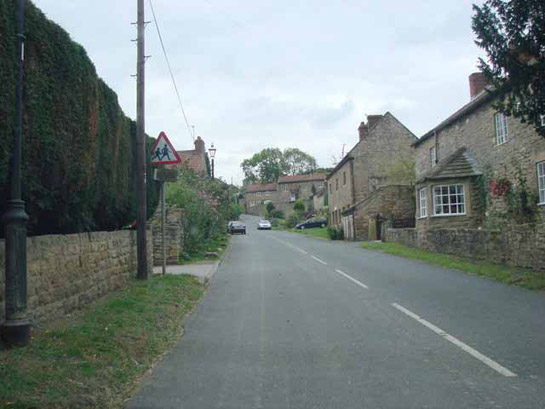
Figure 1: Clayton Lane, Hooton Pagnell
© 2007 Bill Henderson licensed for reuse, http://creativecommons.org/licenses/by-sa/2.0/
The character areas within this zone represent the majority of the areas of nucleated settlement 1 established by the time of the 6inch survey of the Doncaster area by the Ordnance Survey, published between 1851-4.
Character area boundaries within this zone have been drawn to include areas developed by this time and also related peripheral areas, especially plots directly relating to village greens, churches, former manorial sites and open areas surrounded by development. Within this zone, most character areas include some 20th century infill. Where this has respected earlier property boundaries and scales it has generally been included within units of earlier character; where it has introduced new plan forms and patterns it has been shown on the mapping included in the gazetteer as being characteristic of a later period.
These villages typically include a parish church and vernacular buildings of the medieval (1066-1539) and post-medieval (1540-1749) periods. Later developments often include more ‘polite’ architectural forms related to the gentrification of some settlements by landed estates, and the construction of middle class villa housing in the 19th century. In addition, the zone may include brick built terraces dating from the mid 19th century onwards. More recent modifications usually include examples of semi-detached and detached suburban housing, primary schools and replaced shop fronts.
Relationships with Adjacent Character Zones
This zone includes the historic settlement cores of villages that are still isolated within rural countryside, in addition to those that have become absorbed within the large-scale suburbanisation of the borough. Of those still largely associated with enclosed landscapes, clear differences exist according to the historic landscape and geological context of each settlement. Within the ‘Agglomerated Enclosure’ and ‘Surveyed Enclosure’ zones that dominate the Coal Measures and Magnesian Limestone, most settlements are linear nucleations of demonstrably medieval date, often featuring medieval parish churches and constructed to quite regular plans. Historically, these villages were frequently surrounded by common arable open fields, typically enclosed in the post-medieval period.
Further east, across areas underlain by Bunter Sandstone geology, and particularly noticeable within the ‘Piecemeal Enclosure’ zone, are a group of settlements that have much less planned layouts. Examples include: Fishlake, Sykehouse, Braithwaite, Haywood, Fenwick, Hatfield Woodhouse, Cantley, and Branton. These settlements are less likely to feature medieval churches (although they are not unknown) and are more loosely nucleated, often only coalescing into single settlements in the past 150 years.
A further sub-group of the settlements, mostly associated with the Magnesian Limestone ridge, have an important relationship with the ‘Private Parklands’ character zone. This group includes: Campsall, Pickburn and Brodsworth, Hickleton, High Melton, Burghwallis, and Cusworth. In addition, Warmsworth, Marr, Skelbrooke and Cantley are all related to former parklands.
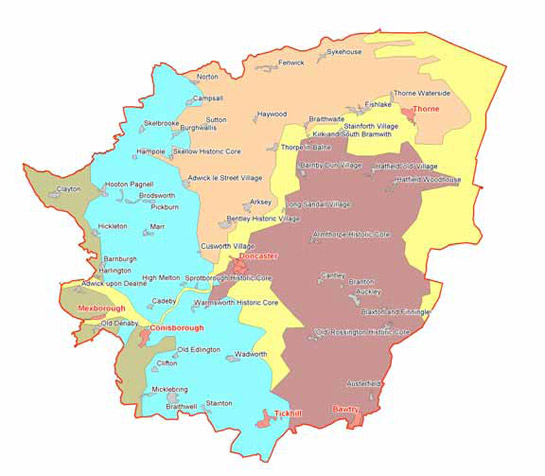
Figure 2: Historic Settlements in Doncaster in relation to underlying solid geology (Complex Historic Town Cores shown in red). Key: Light Brown=Coal Measures; Blue=Magnesian Limestone; Orange=Bunter Sandstones overlain with clays; Dark Brown=Bunter Sandstones overlain with gravels; Yellow=Alluvium and Peat.
© SYAS 2008, map based on Ordnance Survey material with the permission of Ordnance Survey on behalf of the Controller of Her Majesty’s Stationery Office. © Crown Copyright. Unauthorised reproduction infringes Crown copyright and may lead to prosecution or civil proceedings. 100018816. 2007
Villages of this zone are frequently surrounded by areas of mid to late 20th century suburban character. Such suburbanisation can be seen at: Auckley, Barnby Dun, Barnburgh and Harlington, Branton, Cusworth, Norton, Warmsworth, and Wadworth. These suburbs typically began as ribbon development along main roads, before further growth took place as the villages became increasingly attractive to commuters. Most of the smaller villages in this zone have experienced continuing infill of their historic cores and piecemeal replacement of older buildings throughout the 20th century, as part of a similar trend.
A number of these character areas, e.g. Adwick le Street Village; Armthorpe Historic Core; Bentley Historic Village; Hatfield 'old' Village; Old Edlington; Skellow Historic Core; and Stainforth Village, have close relationships to the ‘Planned Industrial Settlement’ zone, with new model villages either planned close to or around their historic cores.
Settlements are largely absent from the ‘Wetland Enclosure’ zone, although the edges of the zone appear to have provided attractive locations from which both wet and dry land resources could be exploited; both Thorne and Fishlake are known to have been important as small ports in this respect. Similarly, Braithwaite, Thorpe in Balne, Barnby Dun and Stainforth occupy locations self consciously placed at the edge of the river Don floodplain and Hatfield Woodhouse sits between areas of formerly dry and wet land.
Inherited Character
By the mid 19th century, villages across Doncaster was typically made up of nucleations of farms and cottages grouped along single roads (often called High Street or Main Street) with each property allocated a narrow plot set perpendicular to the main street, often with ‘back lanes’ providing rear access to the plots set parallel to the main road. These settlements also frequently included a church of medieval origin, most usually with the earliest phase dating to the Norman period - although a number may have pre-conquest origins (Ryder 1982).
Where later development of the settlement consisted of little more than the piecemeal replacement of properties within existing boundaries, the form of the medieval settlement often survives well. Well preserved linear plan villages include: Braithwell, Clifton, Hatfield, Hooton Pagnell, and Sutton. Less well-preserved former planned medieval villages include: Arksey, Aukley, Barnby Dun, Bentley, Braithwell, Micklebring, Norton, Sprotborough, Stainforth and Wadworth.
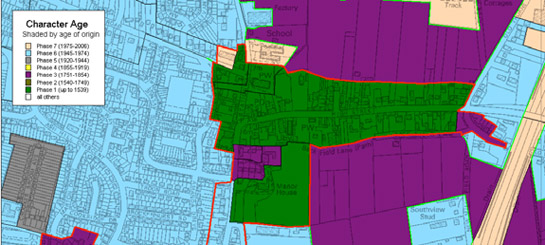
Figure 3: The historic core of Hatfield - showing a clearly planned medieval linear pattern of plots set perpendicular to a main street. Note the well-preserved large enclosure around the medieval manor house to the south west of the series.
© SYAS and © Crown copyright. All rights reserved. Sheffield City Council 100018816. 2007
Comparison of the best-preserved examples of planned medieval villages in this zone with data held in the South Yorkshire SMR reveals that many of these character areas contain known manorial sites dating to the medieval period. Legibility of these sites depends on the level of later growth at the settlement of which it is a part. Where post-medieval and modern growth has been absent or limited, such sites may still include significantly legible components (for example, at Thorpe in Balne).
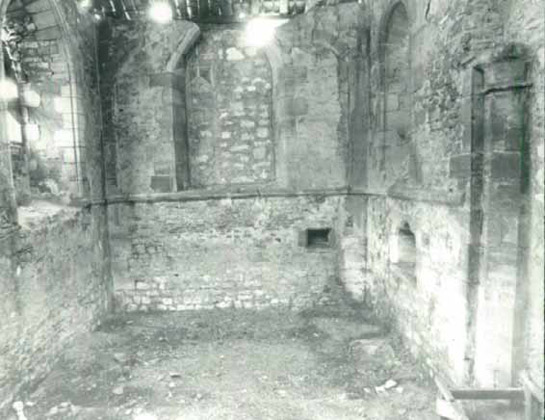
Figure 4: The remains of the chancel of a 12th century chapel at Manor House Farm, Thorpe in Balne, reused as a barn in the post-medieval period.
Photo by PF Ryder 1981 © SYAS
Villages with significant influences from adjacent private parklands are: Campsall, Pickburn and Brodsworth, Hickleton, High Melton, Burghwallis, Cusworth, Warmsworth, Marr, Skelbrooke, and Cantley. These share a number of frequently re-occurring characteristics; there is often clear evidence for either the shrinking or contraction of these medieval settlements before or at the time the parks were landscaped.
At Burghwallis the re-planning of the village took place at some time between the surveying of Thomas Jeffreys’ map of Yorkshire (c.1775) and the 1815 enclosure map for Burghwallis and Haywood (reproduced in Keith 2002). On Jefferys' map, the nucleated core of village is shown clustering around the church and the hall to the east. By the time of the 1815 enclosure map a new core had been established around the 17th century Home Farm, much of which still survives - including the school, smithy and estate cottages. Grange Lane does not appear to have been depicted by Jeffreys and probably represents a diversion of the historic right of way through the village; Burghwallis Hall was built in 1797 and this diversion of an older road around its parkland was deliberate replanning. Evidence for the diversion of main streets and the clearance of areas of medieval planned settlement has also been noted at Cusworth, Cantley, Skelbrooke, High Melton and Brodsworth. Churches from the latter two examples are now isolated by 18th century parkland from other early buildings in these settlements.
Later Characteristics
The later development of these settlements is intimately related to the processes of suburbanisation discussed above. The identification and designation of many historic cores as Conservation Areas in the 1960s and 1970s has served to preserve the character of many of these settlements. Although the criticism that this led to, “the creation of a fossilised village centre containing buildings of historic interest surrounded by areas of dense modern housing of an unsympathetic character” (Magilton 1977, 90) remains valid. Outside of Conservation Areas, or where redevelopment preceded their creation, suburbanisation has frequently reduced the legibility of historic settlement forms. A common cause of this reduction of legibility is the amalgamation of historic plots, in order to produce larger plots of land for the development of estate housing.
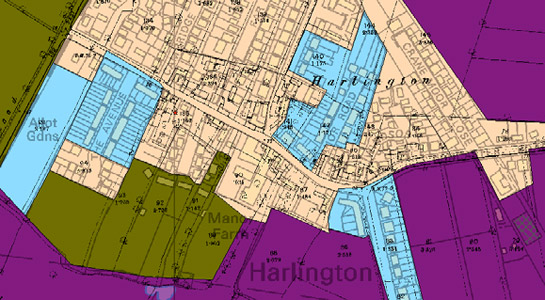
Figure 5: Harlington village is a good example of the extent to which historic character can be lost with late 20th century redevelopment.
Modern map © Crown copyright. All rights reserved. Sheffield City Council 100018816. 2007; historic map © and database right Crown Copyright and Landmark Information Group Ltd (All rights reserved 2008) Licence numbers 000394 and TP0024
Character Areas within this Zone
Map links will open in a new window.
- Adwick le Street Village (Map)
- Adwick upon Dearne (Map)
- Arksey (Map)
- Armthorpe Historic Core (Map)
- Auckley (Map)
- Austerfield (Map)
- Barnburgh (Map)
- Barnby Dun Village (Map)
- Bentley Historic Village (Map)
- Blaxton and Finningley (Map)
- Braithwaite (Map)
- Braithwell (Map)
- Branton (Map)
- Brodsworth (Map)
- Burghwallis (Map)
- Cadeby (Map)
- Campsall (Map)
- Cantley (Map)
- Clayton (Map)
- Clifton (Map)
- Cusworth Village (Map)
- Fenwick (Map)
- Fishlake (Map)
- Hampole (Map)
- Harlington (Map)
- Hatfield 'old' Village (Map)
- Hatfield Woodhouse (Map)
- Haywood (Map)
- Hickleton (Map)
- High Melton (Map)
- Hooton Pagnell (Map)
- Kirk and South Bramwith (Map)
- Long Sandall Village (Map)
- Marr (Map)
- Micklebring (Map)
- Norton (Map)
- Old Denaby (Map)
- Old Edlington (Map)
- 'Old' Rossington Historic Core (Map)
- Pickburn (Map)
- Skelbrooke (Map)
- Skellow Historic Core (Map)
- Sprotborough Historic Core (Map)
- Stainforth Village (Map)
- Stainton (Map)
- Sutton (Map)
- Sykehouse (Map)
- Thorne Waterside (Map)
- Thorpe in Balne (Map)
- Wadworth (Map)
- Warmsworth Historic Core (Map)
Bibliography
- Keith, K.
- 2002 Spindlewood, The Abbe's Walk, Burghwallis, South Yorkshire – Desk Based Assessment [unpublished]. Morley: Archaeological Services WYAS for Fairclough Homes.
- Magilton, J.R.
- 1977 The Doncaster District: an Archaeological Survey. Doncaster: DMBC Museum and Arts Service.
- Roberts, B.K.
- 1996 Landscapes of Settlement; Prehistory to the Present. London: Routledge.
- Ryder, P.
- 1982 Saxon Churches in South Yorkshire. Barnsley: South Yorkshire County Council, Recreation Culture and Health Department.
1 The term ‘nucleated settlement’ is used to describe a pattern of settlement “where buildings are built together in clusters (i.e. hamlets or villages)” (Roberts 1996, 24)
